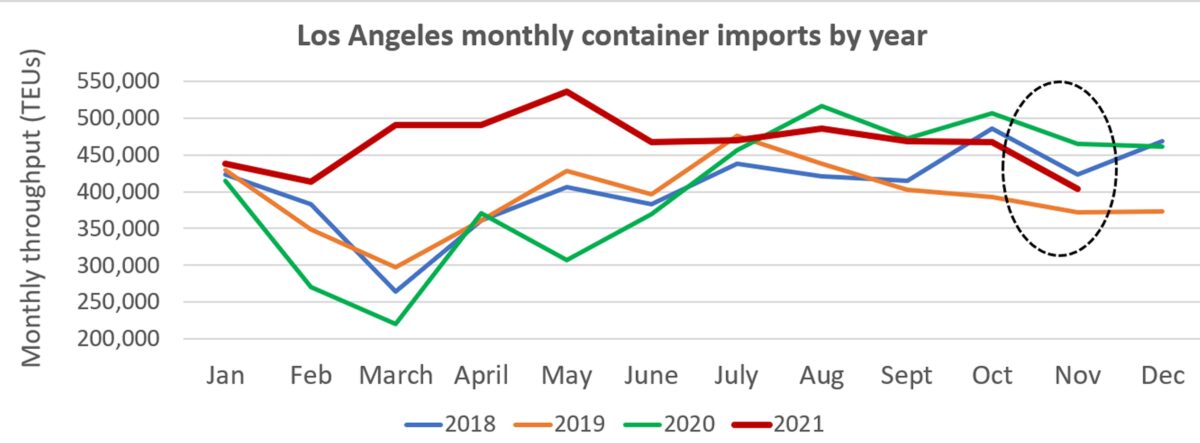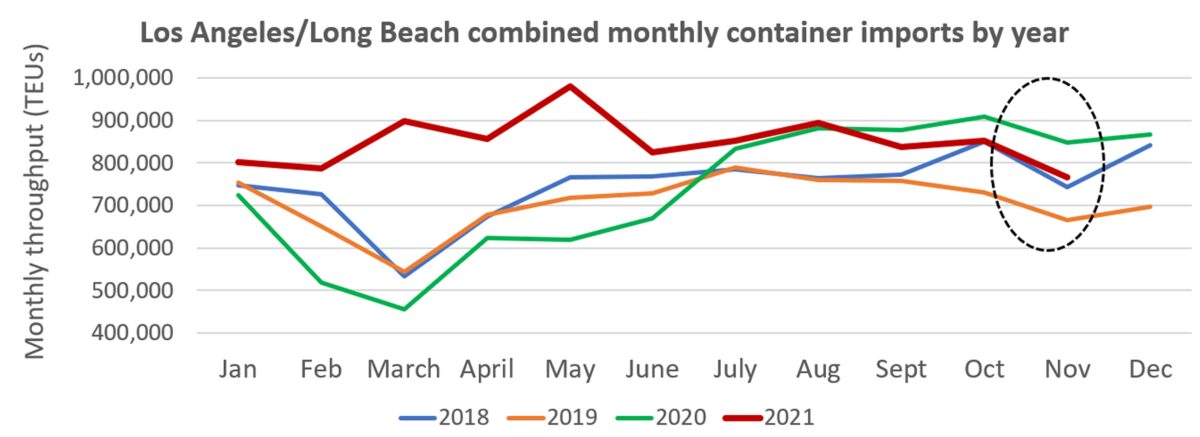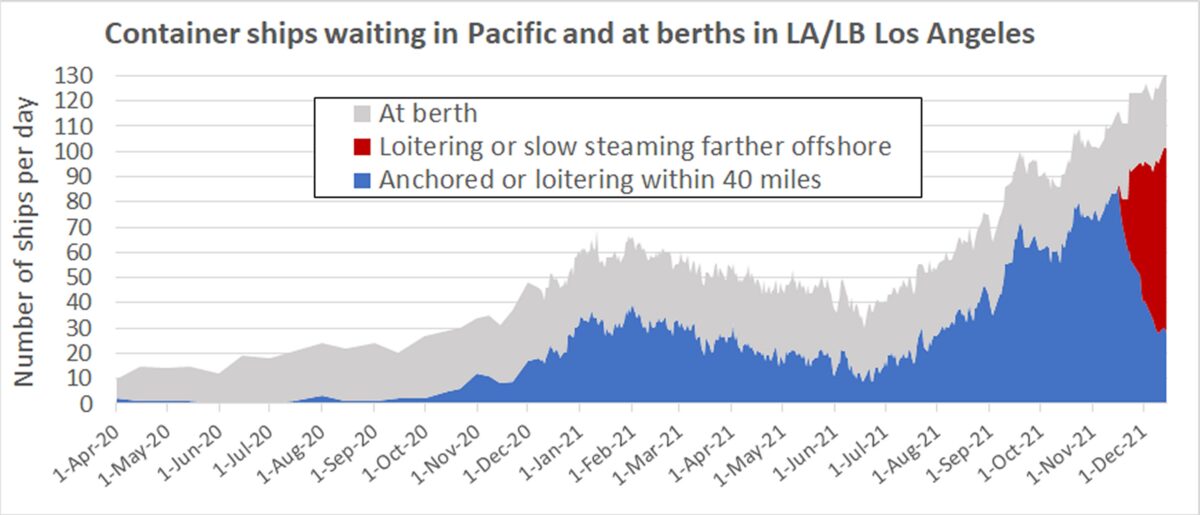Despite America’s epic consumer boom, containerized imports to the Port of Los Angeles dropped to 403,569 twenty-foot equivalent units in November, down 14% from October and down 13.2% year on year. For the second month in a row, Los Angeles’ containerized imports have fallen below levels in the same months in 2018.
On one hand, the Port of Los Angeles will boast record full-year throughput in 2021, including loaded imports, loaded exports and empty containers. Business is booming. Executive Director Gene Seroka said during a press conference Wednesday that the port was on track for 5.5 million TEUs of total throughput this year, 13% above the 2018 peak.
On the other hand, import volumes in Los Angeles were front-loaded in the first half when congestion, while significant, was less severe than it is now. The last time monthly imports to Los Angeles were as low as in November was in June 2020, at a time when ocean carriers were canceling sailings to America due to lockdown-depressed demand.

November’s slide was not due to lower import demand, but due to port congestion coinciding with high demand. The evidence: The amount of cargo stuck waiting offshore of Los Angeles/Long Beach continued to rise as imports handled by the ports fell. In fact, the capacity stuck offshore increased even more than imports declined.
Looking at the San Pedro Bay port complex overall, combined imports to Los Angeles and Long Beach totaled 765,963 TEUs in November, down 10% from both October 2021 and November 2020, and flirting with November 2018 levels.

At the beginning of November, according to data from the Marine Exchange of Southern California, there were waiting vessels with boxes aboard (including container ships and noncontainer ships) with aggregate capacity of 637,329 TEUs. At the end of November, ships with aggregate capacity of 745,305 TEUs were waiting for berths in Los Angeles/Long Beach, up 17% from the beginning of the month.
The capacity of ships stuck off Southern California ports rose 107,976 TEUs over the course of last month, whereas the combined import throughput at the two ports fell 86,324 TEUs in November versus October.
The offshore ship queue has gotten even bigger in December.
According to the Marine Exchange of Southern California, 102 container vessels were waiting for berths in Los Angeles and Long Beach on Wednesday. The combined number of container ships waiting offshore and at the berths is at or near an all-time high.

The aggregate capacity of container ships waiting offshore, as well as noncontainer ships carrying boxes, was 794,962 TEUs on Wednesday, up another 7% from the end of November, according to data from the Marine Exchange. The capacity of ships in the Pacific Ocean queue now exceeds the combined monthly imports of Los Angeles and Long Beach.
The official calculation of the number of ships waiting for berths in Los Angeles/Long Beach recently changed due to a new queuing system to promote vessel safety and clean air. Under the new protocol, ships wait farther offshore and the number of vessels within 40 miles of the port has dramatically decreased.
During Wednesday’s press conference, Seroka addressed what the port spokesperson called “reports suggesting this [new queuing] system is being used as a way to hide or disguise the number of vessels waiting to enter San Pedro Bay.”
Seroka maintained: “There has never been and there never will be any intent to hide data or vessels headed our way. Our goal is to present a transparent and accurate picture of the container vessel count.”
Empty container situation worsening
The executive director discussed a number of key performance indicators — some improving, some worsening.
Dwell time for containers moving by rail has dropped from a high of 13.5 days this summer to just two days, the lowest it has been since pre-COVID. Dwell time of containers moving by truck at Los Angeles terminals is down to six days from a peak of 11 days, Seroka added.

The number of loaded import containers dwelling at terminals for nine or more days is down 56% from Oct. 24, when a new fee for long-dwelling containers was announced by the ports.
Due to continued progress, implementation of the fee has been pushed back each week. “If we go backwards, you bet it will be implemented,” affirmed Seroka. (Port statistics show that reductions in long-dwelling containers have slowed over the past three weeks.)
Two metrics are going in the wrong direction. Street dwell time — the time containers are outside the terminals — “is now at a high of 10 days,” said Seroka. “That needs immediate attention, to bring that number below four days as it was pre-surge.”
The empty container situation is also worsening. There are now 71,000 on Los Angeles terminals or near-dock depots, up from 65,000 a month ago, with 60% dwelling nine days or more.
In November, 325,838 TEUs of empty containers were loaded on ships. That’s up 11% year on year, but it marks yet another decline from the preceding month. In August, 364,212 TEUs of empties were loaded. The volume has declined every month since then.
Seroka warned, “If necessary, we will look at additional measures, including levying fees against liner companies for empty containers that dwell excessively at our marine terminals.”
Click for more articles by Greg Miller
Related articles:
- About that rate relief … ocean shipping costs are rising again
- Biden-backed plan to clear California port congestion stalls
- It’s official: 96 container ships are waiting to dock at SoCal ports
- Ships in California logjam now stuck off Mexico, Taiwan and Japan
- California ship pileup still piling up — but out of sight, over horizon
- $25B worth of cargo stuck on 80 container ships off California












Dave
So the question that no one is asking is how many ships are being unloaded per day? How many containers are being unloaded per day? How many containers are leaving the port complex per day? The drop in numbers can only be one of two things. Either the manpower is not there for unloading (union is not supplying necessary workers) or their containers are stacking up on the docks (which means a shortage of carriers to move them out). My gut tells me the union labor pool dropped dramatically during the Thanksgiving holiday. Everyone went on vacation and ships did not get unloaded. This is why the lines of ships got longer and the empties did not get loaded and stacked up. I predict the same for December when workers will take an entire week off for the Christmas holiday. Remember this was the norm for many years because freight would slow down dramatically in mid-November and the Christmas push ended. Carriers and the Rails did their job as evident by the dwell times. We got to quit looking and the number of ships as the problem and why the throughput through the port has gotten worse. It would be very interesting to compare the numbers between the terminal operators with each other on a daily and weekly basis and especially with the only automated terminal, even though they are handicapped by using union labor for working the cranes. In my opinion, this is all a result of port inefficiencies and the inability over the last many years to automate many functions. I have no problem with the unions except when they stand in the way of progress in the name of job preservation and that is what we are seeing today. The numbers I believe will show the real story.